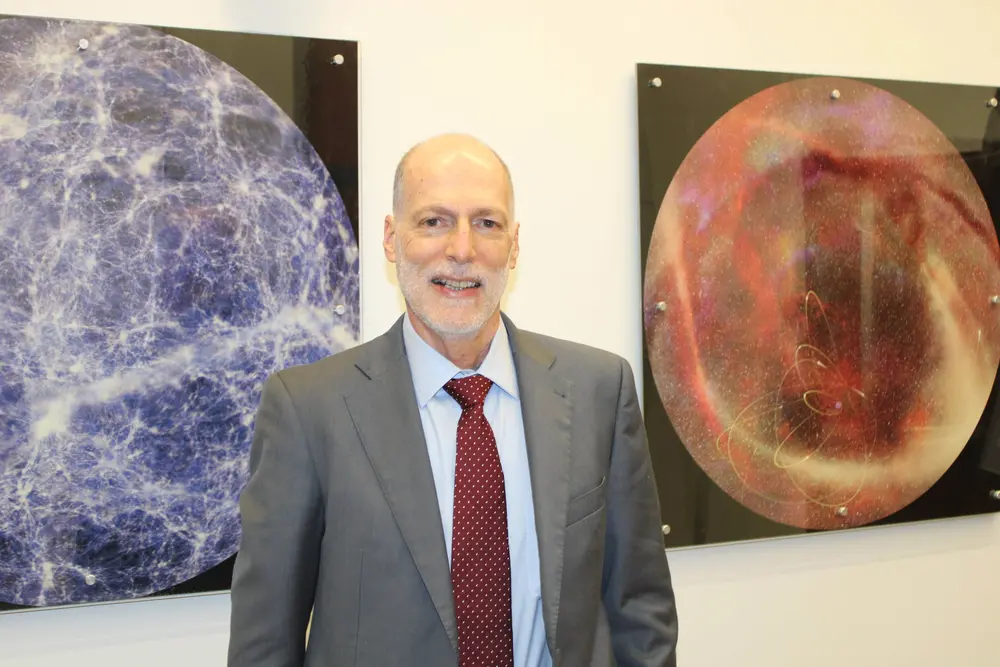
The University of Illinois Department of Astronomy welcomed students, faculty, and alumni to its annual Astrofest event on April 25. Hosted at the National Center for Supercomputing Applications, the day-long celebration of research and discovery featured a mix of poster sessions, lightning talks, demonstrations, and plenary lectures.
Astrofest started with a morning poster session, where students showcased their research across various topics from galaxy formation to virtual reality applications in astronomy. Throughout the day, participants heard from leading faculty members about their work, including talks on neutron stars, galaxy evolution, and the future of astronomical visualization. The event culminated in a keynote address by alum Dr. Phil Jewell (Ph.D., 1982, Astronomy), Deputy Director of the National Radio Astronomy Observatory. He shared his career journey and reflections with the next generation of astronomers.
Jewell also participated in a later panel discussion about career paths after graduate school, offering advice drawn from decades of experience in observational astronomy, leadership, and international collaborations. In his talk, “From the Morrow Plots to the Atacama Desert,” he reflected on his career, from working as a postdoc at the Max-Planck-Institut für Radiostronomie in Bonn, Germany to leading major international projects like the Atacama Large Millimeter/submillimeter Array, and how his experience as a graduate student at Illinois shaped it. His presence offered a glimpse into the professional world awaiting many of the students in the audience and a sense of continuity — a reminder of the department’s long legacy of discovery and the lasting connections forged here.
From Illinois to the frontiers of astronomy
Jewell’s journey through the cosmos began in the basement of the old campus observatory, working below the massive refractor telescope. He quickly became involved with the Vermilion River Observatory, operating a 120-foot telescope in nearby Danville, allowing him to launch his research career. “It was a good telescope,” Jewell recalled. “Having our own instrument available gave us the freedom to do projects that took time.”

His graduate work involved monitoring OH masers—radio emissions from evolved stars wrapped in expanding shells of gas and dust. Jewell and his colleagues measured a 30-day phase lag between the red- and blue-shifted signals, allowing them to calculate the size of these stellar envelopes. “It was a perfect project to start my career," he said. "We had time, we had a telescope, and we had smart people around me. It was a significant, kind of nifty result early on.”
Jewell’s doctoral advisor was Professor Lew Snyder, a pioneer in astrochemistry. “Lew was quite a character, but a very smart scientist,” Jewell said. During his keynote, he recalled a tradition where Snyder would take new graduate students to the Champaign County Fair to see the tractor pull and hog shows to get a true Midwestern experience. “He had a gruff exterior, but a heart of gold underneath it. He gave me a lot of good advice that I really appreciated.” Snyder’s groundbreaking discovery of the first polyatomic molecule in the interstellar medium helped define the emerging field, and his mentorship left a lasting imprint on Jewell’s career.
A global career rooted in Illinois
After earning his Ph.D., Jewell’s path took him around the globe, including postdoctoral work in Bonn, Germany, and leadership roles at premier observatories such as the James Clerk Maxwell Telescope in Hawaii and the Green Bank Telescope in West Virginia. He eventually became the North American Director for ALMA, overseeing major upgrades that pushed the frontiers of star formation research and black hole studies.
Despite his travels, Jewell’s memories of Illinois remain deeply personal. It was in the Department of Astronomy where he not only found his research footing, but also met his wife of 44 years, Christine, who was working as an administrative aide for the department when they first crossed paths. “My biggest takeaway from my time at Illinois,” he said with a smile.
A homecoming filled with energy and gratitude
Returning to campus for Astrofest brought a sense of continuity and excitement for Jewell. “I love being around students. It energizes me,” he said. “Much of my work will long outlive my career, so I’m trying to facilitate things for the next generation of astronomers. It excites me today to come back and tell some old stories and talk about the new stuff that’s going on.”
When asked what advice he would offer today’s students, Jewell didn’t hesitate. “Be bold. Get out of your comfort zone,” he urged. “And make sure you're connected to a good research group. Everyone eventually has to make a name for themselves, but having a strong network of collaborators really helps you along the way.”
For a department built on discovery, having alumni like Phil Jewell return serves as a reminder that a career in astronomy is not only about the stars overhead but also about the people, places, and ideas that guide the way.
